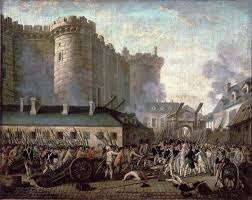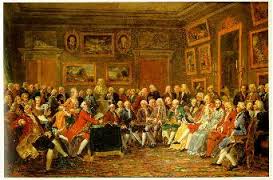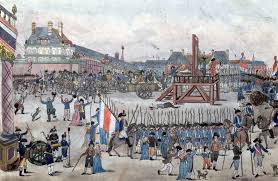French history would change forever in 1789. Throughout the eighteenth century, Enlightenment principles dominated the public sphere and climaxed with the start of the French Revolution. The French faced many obstacles in achieving the goals of the Revolution. The philosophes did not agree on the best form of government, distrust was rampant regarding the sovereign and God, rivaling factions led to political turmoil, royalists were guilty of waging war against revolutionaries, de-Christianization upset a large portion of the population, and constitutions were repeatedly published with differing societal values. The people had the task of figuring out what ideals they wanted in the new government they were trying to create, and this proved difficult. While some ideas were held by a large majority, such as implementing a constitutional monarchy (at least at first), there were always pockets of people who disagreed; those who were disagreeable in this particular case either preferred a republic or were faithful to the monarchy. It is clear that the people had a difficult time adjusting to the societal change that was taking place, even though the ideals in 1789 France were to better society. French revolutionaries pushed for an egalitarian society and many of the outcomes of the initial stage of the Revolution were favorable to their cause, such as the abolition of the monarchy and privilege.
Additionally, the French Revolution was a time of drastic political, social, and economic change. Much of this change can be credited to Enlightenment thought. For example, ideas from the Enlightenment had been circulating in France with the goal to achieve societal change. New books, novels, newspapers, journals, pornography, and plays were created with the objective of spreading ideas about rationality, freedom, liberty, and equality. Additionally, people began conversing differently; ideas spread in coffee houses and taverns over coffee, tea, and drinks. Changes of the Revolution also saw women take on new roles, such as salon hostesses. In salons, people of all classes exchanged ideas. For the first time in centuries in France, it was no longer about who you knew, but what you knew. Further, ideas about privilege also changed. Pierre Beaumarchais, a French playwright, became notorious for satirizing and criticizing societal privilege. People were able to easily pick up on his critiques and cried for an egalitarian society, free of privilege and the nobility. Thus, the Revolution saw great change in France and contributed to rising ideas about freedom and equality. However, there was also a dark side to the Revolution known as the Terror. Although initially well-intentioned, the Terror ultimately ended the egalitarian revolution and began the authoritarian revolution that instated Napoleon.
The Terror swept across Paris during the latter part of the Revolution executing Parisians by the thousands. During this time, a political faction known as the Jacobins controlled the National Convention and dominated the executive branch of government, the Committee of Public Safety. The Jacobins rivaled the Girondins, and the period suffered from political turmoil. It was during this time that the ideals that initially started the Revolution, such as equality for all (all men, anyways) was accomplished. The Constitution of 1793 was largely inspired by the Declaration of the Rights of Man and of the Citizen (1789) and incorporated many of its ideas, such as universal male suffrage and the conservation of the Republic. However, The Terror was the most violent phase of the Revolution. Ideas regarding conspiracy and counter-revolution spread rapidly across France and nearly 17,000 people were executed by guillotine. Most of the Revolution’s most famous leaders, at some point, were executed by guillotine. While the guillotine seems barbaric and inhumane to modern day society, it was actually a huge technological innovation that replaced other punitive punishments, such as hanging and torturing. Nonetheless, while the Terror attempted to keep the Revolution in full swing, it was largely responsible for its death.



Pingback: Dismissing Proper Gender Roles in Revolutionary France: The Case of Madame Roland | Women in European History